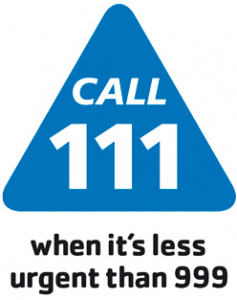Remember movement, activity and a healthy lifestyle including mental wellbeing are all good for your back pain and that there is no one single exercise which is better for your back. Below are a few exercises you could try:
Here is a selection of exercises that you can do regularly to keep your back mobile.
Try to do some mobility exercise every day. If you haven’t exercised recently, start with about 5 of each and build up to 10, making the exercises a little harder as your fitness and flexibility improves.
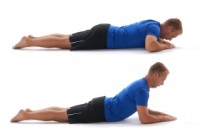
Lie on your tummy, either on the floor or on a bed. Place your hands with palms on the bed/ floor either side of your ears. Slowly push through your hands to straighten your elbows, keeping your hips on the bed/ floor, so that your back arches. Keep your hips down. Repeat.
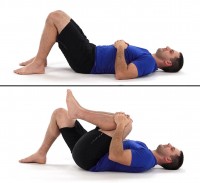 Lie on your back, either on the floor or on a bed. Bring one knee to your chest, then the other, using your hands to pull your knees in to stretch your lower back. Repeat.
Lie on your back, either on the floor or on a bed. Bring one knee to your chest, then the other, using your hands to pull your knees in to stretch your lower back. Repeat.
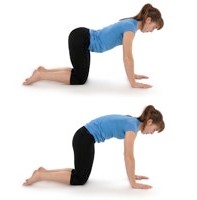 Kneel on all fours on the floor or a bed. Let the middle and lower part of your back relax into a neutral position. Next pull in your tummy and arch your back up toward the ceiling to feel a stretch in your back, then lower again. Repeat
Kneel on all fours on the floor or a bed. Let the middle and lower part of your back relax into a neutral position. Next pull in your tummy and arch your back up toward the ceiling to feel a stretch in your back, then lower again. Repeat
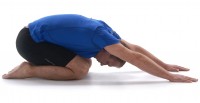 Kneel on the floor or on a bed with your bottom on your heels. Place your hands on the floor/ bed above your head reaching as far as you can to stretch. Repeat.
Kneel on the floor or on a bed with your bottom on your heels. Place your hands on the floor/ bed above your head reaching as far as you can to stretch. Repeat.
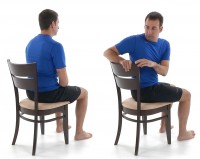 Sitting on a chair with a back, rotate your body slowly one way and use the back of the chair to pull yourself round for a good stretch. Repeat to the other side.
Sitting on a chair with a back, rotate your body slowly one way and use the back of the chair to pull yourself round for a good stretch. Repeat to the other side.
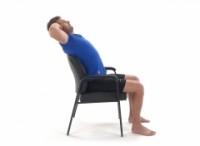 Sitting on a chair with a back, support your head with your hands and arch back over the chair-back to stretch. You can alter your position on the chair to stretch different parts of your back.
Sitting on a chair with a back, support your head with your hands and arch back over the chair-back to stretch. You can alter your position on the chair to stretch different parts of your back.
Here is a selection of exercises to improve your muscles.
Try to do some of these exercises twice or three times a week. If you haven’t exercised recently, start with about 5 of each and build up to 10 and so on. Over time you may be able to gradually build up the length of time you can hold each position, and/or the number of repetitions.
 Lying on your back on the floor or on a bed with your knees bent, raise your bottom up slowly and then lower back down slowly. Repeat.
Lying on your back on the floor or on a bed with your knees bent, raise your bottom up slowly and then lower back down slowly. Repeat.

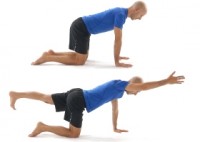 Kneeling on all fours on the floor or on a bed, slowly raise one arm and the opposite leg, keeping balanced and without your back dropping into an arched position.
Kneeling on all fours on the floor or on a bed, slowly raise one arm and the opposite leg, keeping balanced and without your back dropping into an arched position.
Repeat with the other arm and leg.
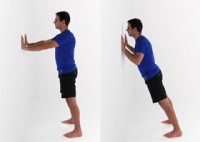 Stand facing a wall, with your hands resting on the wall. Lean your weight on your hands and bend your arms slowly, then straighten them again slowly, so that you are doing a ‘push-up’ on the wall. Keep your back and legs straight the whole time.
Stand facing a wall, with your hands resting on the wall. Lean your weight on your hands and bend your arms slowly, then straighten them again slowly, so that you are doing a ‘push-up’ on the wall. Keep your back and legs straight the whole time.
 Stand holding a small weight in each hand (the weight will depend on how strong you are, and can be increased as you get stronger). Bend your knees and lower the weights toward the floor slowly, then rise into a standing position again. Repeat.
Stand holding a small weight in each hand (the weight will depend on how strong you are, and can be increased as you get stronger). Bend your knees and lower the weights toward the floor slowly, then rise into a standing position again. Repeat.
For your general fitness, choose an activity that you can do regularly such as walking, cycling, swimming or yoga. The main thing is that you pick something you enjoy and stick to it!
You may want to look at some more exercise options on the NHS-fitness-studio
Image credits: Physiotec

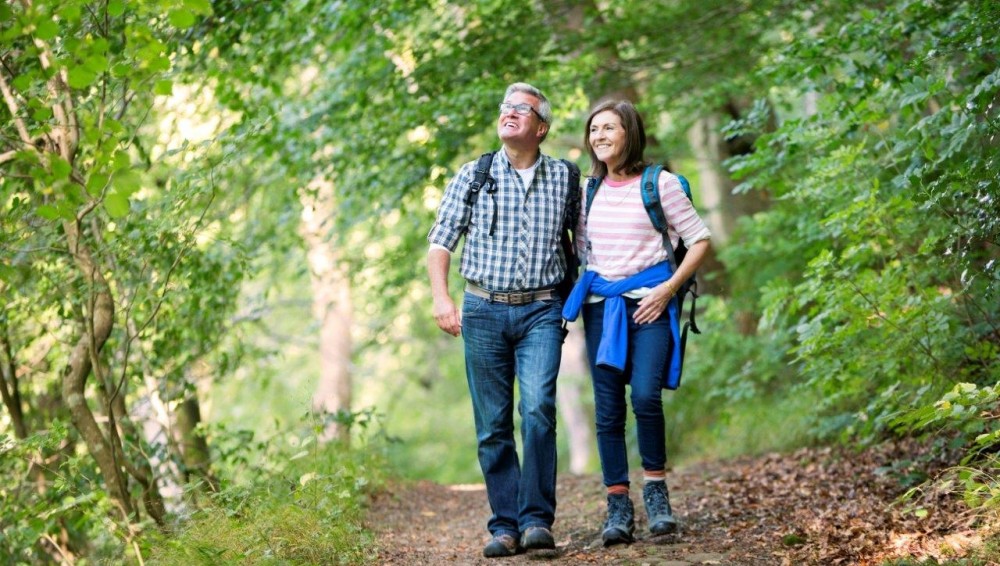
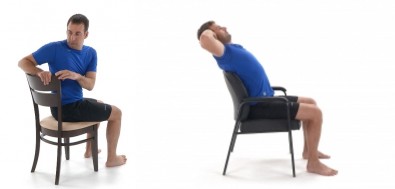

 Lie on your back, either on the floor or on a bed. Bring one knee to your chest, then the other, using your hands to pull your knees in to stretch your lower back. Repeat.
Lie on your back, either on the floor or on a bed. Bring one knee to your chest, then the other, using your hands to pull your knees in to stretch your lower back. Repeat. Kneel on all fours on the floor or a bed. Let the middle and lower part of your back relax into a neutral position. Next pull in your tummy and arch your back up toward the ceiling to feel a stretch in your back, then lower again. Repeat
Kneel on all fours on the floor or a bed. Let the middle and lower part of your back relax into a neutral position. Next pull in your tummy and arch your back up toward the ceiling to feel a stretch in your back, then lower again. Repeat Kneel on the floor or on a bed with your bottom on your heels. Place your hands on the floor/ bed above your head reaching as far as you can to stretch. Repeat.
Kneel on the floor or on a bed with your bottom on your heels. Place your hands on the floor/ bed above your head reaching as far as you can to stretch. Repeat. Sitting on a chair with a back, rotate your body slowly one way and use the back of the chair to pull yourself round for a good stretch. Repeat to the other side.
Sitting on a chair with a back, rotate your body slowly one way and use the back of the chair to pull yourself round for a good stretch. Repeat to the other side. Sitting on a chair with a back, support your head with your hands and arch back over the chair-back to stretch. You can alter your position on the chair to stretch different parts of your back.
Sitting on a chair with a back, support your head with your hands and arch back over the chair-back to stretch. You can alter your position on the chair to stretch different parts of your back.  Lying on your back on the floor or on a bed with your knees bent, raise your bottom up slowly and then lower back down slowly. Repeat.
Lying on your back on the floor or on a bed with your knees bent, raise your bottom up slowly and then lower back down slowly. Repeat.
 Kneeling on all fours on the floor or on a bed, slowly raise one arm and the opposite leg, keeping balanced and without your back dropping into an arched position.
Kneeling on all fours on the floor or on a bed, slowly raise one arm and the opposite leg, keeping balanced and without your back dropping into an arched position. Stand facing a wall, with your hands resting on the wall. Lean your weight on your hands and bend your arms slowly, then straighten them again slowly, so that you are doing a ‘push-up’ on the wall. Keep your back and legs straight the whole time.
Stand facing a wall, with your hands resting on the wall. Lean your weight on your hands and bend your arms slowly, then straighten them again slowly, so that you are doing a ‘push-up’ on the wall. Keep your back and legs straight the whole time. Stand holding a small weight in each hand (the weight will depend on how strong you are, and can be increased as you get stronger). Bend your knees and lower the weights toward the floor slowly, then rise into a standing position again. Repeat.
Stand holding a small weight in each hand (the weight will depend on how strong you are, and can be increased as you get stronger). Bend your knees and lower the weights toward the floor slowly, then rise into a standing position again. Repeat. 